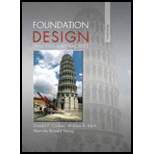
Concept explainers
A certain column carries a vertical downward load of 1,200 kN. It is to be supported on a 1 m deep, square footing. The soil beneath this footing has the following properties:
Learn your wayIncludes step-by-step video

Chapter 7 Solutions
Foundation Design: Principles and Practices (3rd Edition)
Additional Engineering Textbook Solutions
INTERNATIONAL EDITION---Engineering Mechanics: Statics, 14th edition (SI unit)
BASIC BIOMECHANICS
Concepts Of Programming Languages
Java: An Introduction to Problem Solving and Programming (8th Edition)
Thermodynamics: An Engineering Approach
Starting Out with Java: From Control Structures through Data Structures (4th Edition) (What's New in Computer Science)
- A hanging cable supports a single mass of 27,000 lbs ). Assuming that the weight of the cable is negligible, what is the force in the compression member that holds the ends of the cable apart? What is the force in each segment of the cable? Please solve this question numerically, using equilibrium equations.arrow_forwardStar Star to Dalta EX: find the Reg Resistance Sthan A and B 10 A ML lon MWL lon 102 ww bo monedasarrow_forwardF1 ୪ α В F2 You and your friends are planning to move the log. The log needs to be moved straight in the x-axis direction and it takes a combined force of 2.9 kN. You (F1) are able to exert 610 N at a 32°. What magnitude (F2) and direction (B) do you needs your friends to pull? = Your friends had to pull at: magnitude in Newton, F2 = 2405 direction in degrees, B = -7.72 × N × degarrow_forward
- Need hekoarrow_forwardA B 0 B F C The force F = 319 N acts on the frame shown in picture. Resolve this force into components acting along memebers AB and AC to determine the magnitude of each component. The angle mesurements are 0 = 33° and B = 40°. magnitude in member AB in Newton: N magnitude in memeber AC in Newton: Narrow_forwardThe force vector F has a magnitude of F = 450 lb and acts 15.7° with respect to vertical as at point A at an angle → = shown. The force F is balanced by the tension forces parallel to the two rods AC and AB such that the vector equation → F+F AC + FAB = 0 is satisfied. Determine the tension forces in the two rods in Cartesian Vector Notation. с a b B CC + BY NC SA 2013 Michael Swanbom A NF Values for dimensions on the figure are given in the following table. Note the figure may not be to scale. Variable Value a 5.9 ft b C 3 ft 3.1 ft FAC = FAB= ĵ) lb lb + +arrow_forward
- F2 Y B V 5 4 3 F1 X F3 → The given forces are F₁ = 20 kN, F2= 28 kN, and F3 = 61 kN, with given ratio for F₁ and angles of B = 51° and y = 67°. Find the resultant force. First in Cartesian Vector Notation: FR = 2 + j) kN Then, find the magnitude and direction: magnitude in kN: kN conventional direction (counter clockwise from positive X axis) in degrees: degarrow_forwardY F1 α В X F2 You and your friends are planning to move the log. The log. needs to be moved straight in the x-axis direction and it takes a combined force of 2.9 kN. You (F1) are able to exert 610 N at a = 32°. What magnitude (F2) and direction (B) do you needs your friends to pull? Your friends had to pull at: magnitude in Newton, F2 = direction in degrees, ẞ = N degarrow_forwardMy desk has a weight of 193.044 lbf on the Earch's surface where the acceleration of gravity is 32.174 ft $2 What is its weight in pounds force (lbf) on Mars and its mass in pounds mass (lbm) on Mars where the acceleration of gravity is 5.35 ft $2 Weightmars = lbf, Massmars = Ibmarrow_forward
- Y F1 α В X F2 You and your friends are planning to move the log. The log. needs to be moved straight in the x-axis direction and it takes a combined force of 2.9 kN. You (F1) are able to exert 610 N at a = 32°. What magnitude (F2) and direction (B) do you needs your friends to pull? Your friends had to pull at: magnitude in Newton, F2 = direction in degrees, ẞ = N degarrow_forwardY F1 α В X F2 You and your friends are planning to move the log. The log. needs to be moved straight in the x-axis direction and it takes a combined force of 2.9 kN. You (F1) are able to exert 610 N at a = 32°. What magnitude (F2) and direction (B) do you needs your friends to pull? Your friends had to pull at: magnitude in Newton, F2 = direction in degrees, ẞ = N degarrow_forwardPlease show all steps and give answers in the cartesian coordinate system providedarrow_forward
 Principles of Foundation Engineering (MindTap Cou...Civil EngineeringISBN:9781337705028Author:Braja M. Das, Nagaratnam SivakuganPublisher:Cengage Learning
Principles of Foundation Engineering (MindTap Cou...Civil EngineeringISBN:9781337705028Author:Braja M. Das, Nagaratnam SivakuganPublisher:Cengage Learning Fundamentals of Geotechnical Engineering (MindTap...Civil EngineeringISBN:9781305635180Author:Braja M. Das, Nagaratnam SivakuganPublisher:Cengage Learning
Fundamentals of Geotechnical Engineering (MindTap...Civil EngineeringISBN:9781305635180Author:Braja M. Das, Nagaratnam SivakuganPublisher:Cengage Learning Principles of Geotechnical Engineering (MindTap C...Civil EngineeringISBN:9781305970939Author:Braja M. Das, Khaled SobhanPublisher:Cengage Learning
Principles of Geotechnical Engineering (MindTap C...Civil EngineeringISBN:9781305970939Author:Braja M. Das, Khaled SobhanPublisher:Cengage Learning Principles of Foundation Engineering (MindTap Cou...Civil EngineeringISBN:9781305081550Author:Braja M. DasPublisher:Cengage Learning
Principles of Foundation Engineering (MindTap Cou...Civil EngineeringISBN:9781305081550Author:Braja M. DasPublisher:Cengage Learning



